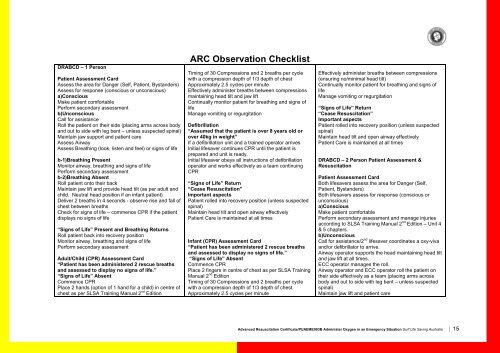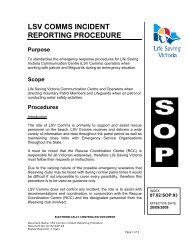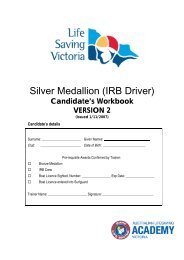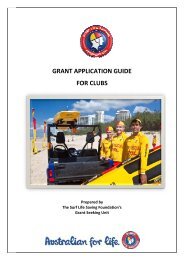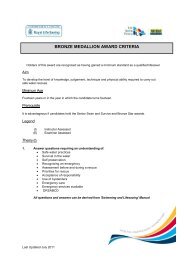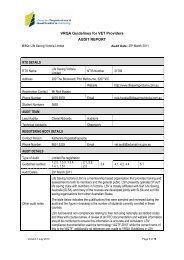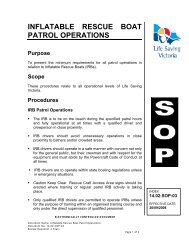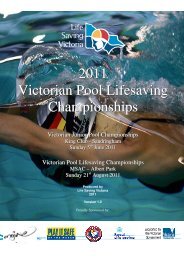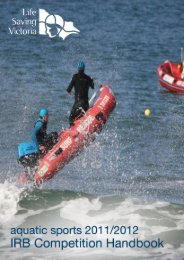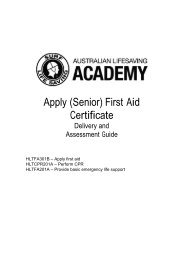Administering oxygen therapy - Life Saving Victoria
Administering oxygen therapy - Life Saving Victoria
Administering oxygen therapy - Life Saving Victoria
You also want an ePaper? Increase the reach of your titles
YUMPU automatically turns print PDFs into web optimized ePapers that Google loves.
ARC Observation Checklist<br />
DRABCD – 1 Person<br />
Patient Assessment Card<br />
Timing of 30 Compressions and 2 breaths per cycle<br />
with a compression depth of 1/3 depth of chest<br />
Effectively administer breaths between compressions<br />
(ensuring no/minimal head tilt)<br />
Assess the area for Danger (Self, Patient, Bystanders) Approximately 2.5 cycles per minute<br />
Continually monitor patient for breathing and signs of<br />
Assess for response (conscious or unconscious) Effectively administer breaths between compressions life<br />
a)Conscious<br />
maintaining head tilt and jaw lift<br />
Manage vomiting or regurgitation<br />
Make patient comfortable<br />
Continually monitor patient for breathing and signs of<br />
Perform secondary assessment<br />
life<br />
“Signs of <strong>Life</strong>” Return<br />
b)Unconscious<br />
Manage vomiting or regurgitation<br />
“Cease Resuscitation”<br />
Call for assistance<br />
Important aspects<br />
Roll the patient on their side (placing arms across body Defibrillation<br />
Patient rolled into recovery position (unless suspected<br />
and out to side with leg bent – unless suspected spinal) “Assumed that the patient is over 8 years old or spinal)<br />
Maintain jaw support and patient care<br />
over 40kg in weight”<br />
Maintain head tilt and open airway effectively<br />
Assess Airway<br />
If a defibrillation unit and a trained operator arrives Patient Care is maintained at all times<br />
Assess Breathing (look, listen and feel) or signs of life Initial lifesaver continues CPR until the patient is<br />
prepared and unit is ready.<br />
b-1)Breathing Present<br />
Initial lifesaver obeys all instructions of defibrillation DRABCD – 2 Person Patient Assessment &<br />
Monitor airway, breathing and signs of life<br />
Perform secondary assessment<br />
b-2)Breathing Absent<br />
operator and works effectively as a team continuing<br />
CPR<br />
Resuscitation<br />
Patient Assessment Card<br />
Roll patient onto their back<br />
“Signs of <strong>Life</strong>” Return<br />
Both lifesavers assess the area for Danger (Self,<br />
Maintain jaw lift and provide head tilt (as per adult and “Cease Resuscitation”<br />
Patient, Bystanders)<br />
child. Neutral head position if an infant patient) Important aspects Both lifesavers assess for response (conscious or<br />
Deliver 2 breaths in 4 seconds - observe rise and fall of Patient rolled into recovery position (unless suspected unconscious)<br />
chest between breaths<br />
spinal)<br />
a)Conscious<br />
Check for signs of life – commence CPR if the patient Maintain head tilt and open airway effectively<br />
Make patient comfortable<br />
displays no signs of life<br />
“Signs of <strong>Life</strong>” Present and Breathing Returns<br />
Patient Care is maintained at all times<br />
Perform secondary assessment and manage injuries<br />
according to SLSA Training Manual 2<br />
Edition – Unit 4<br />
& 5 chapters.<br />
Roll patient back into recovery position<br />
b)Unconscious<br />
Monitor airway, breathing and signs of life<br />
Infant (CPR) Assessment Card<br />
nd<br />
Call for assistance/2 lifesaver coordinates a oxy-viva<br />
Perform secondary assessment<br />
“Patient has been administered 2 rescue breaths and/or defibrillator to arrive.<br />
Adult/Child (CPR) Assessment Card<br />
and assessed to display no signs of life.”<br />
“Signs of <strong>Life</strong>” Absent<br />
Airway operator supports the head maintaining head tilt<br />
and jaw lift at all times.<br />
“Patient has been administered 2 rescue breaths Commence CPR<br />
ECC operator manages the roll.<br />
and assessed to display no signs of life.”<br />
“Signs of <strong>Life</strong>” Absent<br />
Place 2 fingers in centre of chest as per SLSA Training<br />
nd<br />
Manual 2 Edition<br />
Airway operator and ECC operator roll the patient on<br />
their side effectively as a team (placing arms across<br />
Commence CPR<br />
Timing of 30 Compressions and 2 breaths per cycle body and out to side with leg bent – unless suspected<br />
Place 2 hands (option of 1 hand for a child) in centre of with a compression depth of 1/3 depth of chest. spinal)<br />
chest as per SLSA Training Manual 2 nd Edition<br />
Approximately 2.5 cycles per minute<br />
Maintain jaw lift and patient care<br />
Advanced Resuscitation Certificate/PUAEME003B Administer Oxygen in an Emergency Situation Surf <strong>Life</strong> <strong>Saving</strong> Australia | 15


